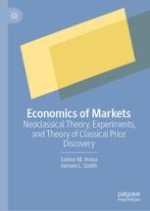2022 | OriginalPaper | Buchkapitel
4. Price Formation: Overview of the Theory
verfasst von : Sabiou M. Inoua, Vernon L. Smith
Erschienen in: Economics of Markets
Aktivieren Sie unsere intelligente Suche, um passende Fachinhalte oder Patente zu finden.
Wählen Sie Textabschnitte aus um mit Künstlicher Intelligenz passenden Patente zu finden. powered by
Markieren Sie Textabschnitte, um KI-gestützt weitere passende Inhalte zu finden. powered by
